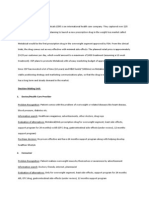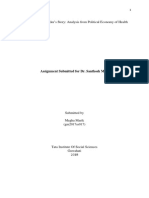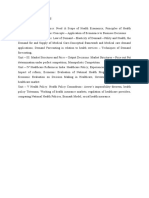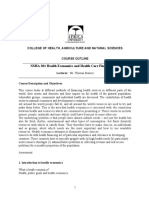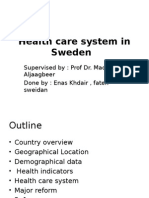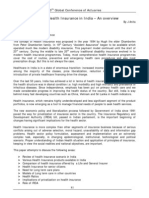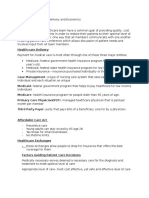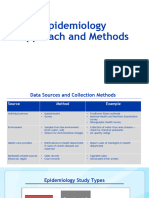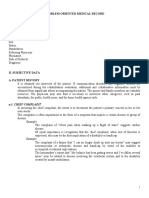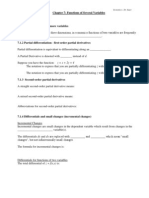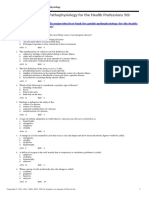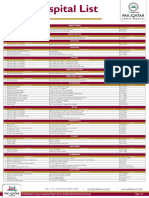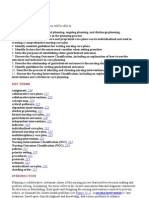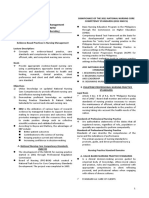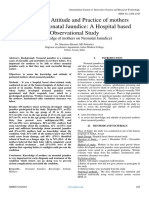Health Economics - Lecture Ch01
Health Economics - Lecture Ch01
Uploaded by
Katherine SauerCopyright:
Available Formats
Health Economics - Lecture Ch01
Health Economics - Lecture Ch01
Uploaded by
Katherine SauerOriginal Title
Copyright
Available Formats
Share this document
Did you find this document useful?
Is this content inappropriate?
Copyright:
Available Formats
Health Economics - Lecture Ch01
Health Economics - Lecture Ch01
Uploaded by
Katherine SauerCopyright:
Available Formats
Introduction to Health Economics
Dr. Katherine Sauer Metropolitan State College of Denver Health Economics
Outline: I. What is Health Economics? II. The Relevance of Health Economics III. Economic Methods of Analysis IV. Does Economics Really Apply to Health Care? V. Is health care so different that it needs its own branch of economics?
I. What is Health Economics?
Health economics is the study of how (scarce) resources are allocated to and within the health economy.
Who are the health economists? - 96% hold Ph.D.s, nearly in economics - 64% work in a university setting (24% in econ departments, 26% in public health, 18% in med schools) - 15% work for nonprofit organizations and -12% work for government (mostly federal)
What do health economists do? 50% study the behavior of individuals 34% study the behavior of firms 50% study government policies 48% study health insurance 50% study outcomes research 31% study other issues
II. The Relevance of Health Economics
Health Spending in the US
National Health Expenditures (NHE)
Source: Centers for Medicare and Medicaid Services , Offices of the Actuary: Data from the National Health Statistics Group http://www.cms.hhs.gov/NationalHealthExpendData/
Health Care Spending as a share of GDP
Source: OECD Health Data 2008
In a share calculation, general inflation is cancelled out. Why has the health care share been increasing?
Per Capita Expenditures on Health Care
Spending per capita in PPP dollars
Source: OECD Health Data 2008
Health Care and the Labor Force (2007)
Source: BLS.gov
Capital Investment
Source: OECD Health Data 2008
III. Economic Methods of Analysis A. Features of Economic Analysis - Scarcity of societal resources - Assumption of rational decision making - Concept of marginal analysis - Use of economic models
B. An Example (1975) Milton Friedman and Simon Kuznets (both later Nobel laureates) studied the so-called physician shortage of the 1930s. - physicians earned 32 % per year more than dentists - training costs were 17 % higher - attributed part of the higher returns on investment to barriers to entry into the medical profession
IV. Does Economics Really Apply to Health Care?
Are health care consumers rational? Do they calculate optimally at the margin? Does price matter?
The coinsurance rate is the percent that the patient pays out of pocket. As the coinsurance rate falls, people are paying less out of pocket. What is the impact on utilizing services?
V. Is health care so different that it needs its own branch of economics? distinctive features of the health sector: - presence and extent of uncertainty - prominence of insurance - information asymmetry - role of nonprofit firms - restrictions on competition - role of equity and need - government subsidies and public provision
You might also like
- Metabical Case Study SolutionDocument4 pagesMetabical Case Study Solutionparoengineer100% (8)
- InnoTech Scholarship 2019 ReportDocument72 pagesInnoTech Scholarship 2019 ReportInnoTech Scholarship0% (1)
- 1 Global HealthDocument44 pages1 Global HealthSuad AbdulmajedNo ratings yet
- Lec 4 Principles of Health Financing PDFDocument6 pagesLec 4 Principles of Health Financing PDFRem Alfelor100% (1)
- Review of Rakkus Story PDFDocument8 pagesReview of Rakkus Story PDFsanjnu50% (2)
- Cost EffectivenessDocument1 pageCost EffectivenessIswahyudi Alamsyah100% (1)
- Community Health Nursing Standards of Practice PDFDocument2 pagesCommunity Health Nursing Standards of Practice PDFMariaNo ratings yet
- Worksheet Price ControlsDocument1 pageWorksheet Price ControlsKatherine Sauer100% (1)
- 3.1 Concept of Health EconomicsDocument4 pages3.1 Concept of Health EconomicsmitalptNo ratings yet
- Health Economics HealthDocument9 pagesHealth Economics HealthAparna Kingini100% (2)
- Chapter 1Document26 pagesChapter 1David Raju GollapudiNo ratings yet
- SHA301 Health Economics and Health FinancingDocument3 pagesSHA301 Health Economics and Health FinancingThomas MaseseNo ratings yet
- Health Economics 2Document4 pagesHealth Economics 2Rira Fauziah INo ratings yet
- Health Economics - Lecture Ch13Document39 pagesHealth Economics - Lecture Ch13Katherine SauerNo ratings yet
- Health Economics - Lecture Ch12Document61 pagesHealth Economics - Lecture Ch12Katherine SauerNo ratings yet
- health care system of swedenبDocument34 pageshealth care system of swedenبAhmedAljebouli0% (1)
- My PresentationDocument14 pagesMy PresentationnamithaNo ratings yet
- Health Financing: Dr. Jamelah R. Usman-PasagiDocument27 pagesHealth Financing: Dr. Jamelah R. Usman-PasagiGada AbdulcaderNo ratings yet
- Theories and ApproachesDocument13 pagesTheories and ApproachesPrince Rupee GonzalesNo ratings yet
- Basic Concepts of Health EconomicsDocument104 pagesBasic Concepts of Health Economicsyihalem100% (1)
- Tools of Health Economics PDFDocument53 pagesTools of Health Economics PDFAdnan RahatNo ratings yet
- Health EconomicsDocument114 pagesHealth EconomicsGeneva Ruz BinuyaNo ratings yet
- Grossman M. (1972) PDFDocument33 pagesGrossman M. (1972) PDFMichele DalenaNo ratings yet
- Standard of LivingDocument4 pagesStandard of Livingmy shadowNo ratings yet
- Demographic Transition Model V2Document11 pagesDemographic Transition Model V2Paula GómezNo ratings yet
- Definitions of Health EconomicsDocument10 pagesDefinitions of Health EconomicsSree LathaNo ratings yet
- Universal Health CoverageDocument44 pagesUniversal Health CoverageSaurabh JainNo ratings yet
- Health Care Financing - 8Document13 pagesHealth Care Financing - 8copy smart50% (2)
- Government Schemes For Senior Citizens: 1.1 Concept and DefinitionDocument16 pagesGovernment Schemes For Senior Citizens: 1.1 Concept and DefinitionRajasekaranindia2002No ratings yet
- Hospital Management Unit - I: Dr.G.Sudha, Pfof/BmeDocument18 pagesHospital Management Unit - I: Dr.G.Sudha, Pfof/BmeAlembante MollaNo ratings yet
- Health Insurance in IndiaDocument16 pagesHealth Insurance in IndiaRuchir Sharda100% (1)
- Budgeting in Health Care System in IndiaDocument16 pagesBudgeting in Health Care System in IndiaABINASHNo ratings yet
- Emerging Health Insurance in India-An Overview - J AnithaDocument17 pagesEmerging Health Insurance in India-An Overview - J AnithaSwayam Suraj Nayak100% (1)
- Scope of Health EconomicsDocument33 pagesScope of Health EconomicsSanjeev Chougule100% (2)
- IntroductionDocument7 pagesIntroductionMadhu Bishnoi100% (1)
- Indian Public Health Standard IIDocument19 pagesIndian Public Health Standard IIKailash NagarNo ratings yet
- A Strategic Approach To Reproductive, Maternal, Newborn, Child and Adolescent Health (RMNCH+A) in IndiaDocument81 pagesA Strategic Approach To Reproductive, Maternal, Newborn, Child and Adolescent Health (RMNCH+A) in IndiaJennifer Pearson-Paredes100% (3)
- Salient Features of National Health Policy 2017Document7 pagesSalient Features of National Health Policy 2017rajsandhu25No ratings yet
- Budgeting in HealthcareDocument10 pagesBudgeting in Healthcarepurity NgasiNo ratings yet
- National Population PolicyDocument23 pagesNational Population Policysaarika_saini1017No ratings yet
- Chapter 2 Healthcare Delivery and EconomicsDocument3 pagesChapter 2 Healthcare Delivery and EconomicsTee WoodNo ratings yet
- Concept of HealthDocument20 pagesConcept of HealthMOZAIDNo ratings yet
- Health, Its Concepts Determinants AND MeasurementsDocument40 pagesHealth, Its Concepts Determinants AND MeasurementsMamta RajputNo ratings yet
- Institutional HealthDocument2 pagesInstitutional HealthKakembo NoreenNo ratings yet
- Workshop On Healthcare Sector-Opportunities and Challenges in Hospital-FinalDocument38 pagesWorkshop On Healthcare Sector-Opportunities and Challenges in Hospital-FinalRavindra Pratap GuptaNo ratings yet
- Epidemiology Approach and MethodsDocument50 pagesEpidemiology Approach and MethodsBen PhiriNo ratings yet
- Health EconomicsDocument227 pagesHealth EconomicsagezeNo ratings yet
- Social & Preventive MedicineDocument12 pagesSocial & Preventive Medicinedrsumanthmmc100% (1)
- Dr. Padma Bhatia: Assistant Professor Department of Community Medicine G.M.C., Bhopal. M.P. IndiaDocument30 pagesDr. Padma Bhatia: Assistant Professor Department of Community Medicine G.M.C., Bhopal. M.P. IndiaSakshi SuriNo ratings yet
- GLOBAL HEALTH TRENDS JUNE 13th 2024 2NDDocument30 pagesGLOBAL HEALTH TRENDS JUNE 13th 2024 2NDdoctoramitgupta100No ratings yet
- Rashtriya Arogya Nidhi (RAN) and Health Minister's Discretionary Grants (HMDG)Document48 pagesRashtriya Arogya Nidhi (RAN) and Health Minister's Discretionary Grants (HMDG)AMIT HAPASENo ratings yet
- Sociology and HealthDocument14 pagesSociology and HealthPriyanka GoswamiNo ratings yet
- 1, Health Services Management Lecture NotesDocument8 pages1, Health Services Management Lecture Notessamuel sesayNo ratings yet
- Ayushman Bharat YojanaDocument28 pagesAyushman Bharat YojanaParth VasaveNo ratings yet
- Health Economics - SyllabusDocument3 pagesHealth Economics - SyllabusKatherine Sauer100% (2)
- Health Information SystemDocument13 pagesHealth Information SystemSimran WaghelaNo ratings yet
- Cost Effectiveand AnalysisDocument15 pagesCost Effectiveand AnalysisGayathri RNo ratings yet
- Unit 9. Epidemic InvestigationDocument57 pagesUnit 9. Epidemic Investigationbereket gashuNo ratings yet
- Quality Assurance in Community Health Nursing: December 2019Document5 pagesQuality Assurance in Community Health Nursing: December 2019jbd365No ratings yet
- The Medical Termination of Pregnancy Act, 1971Document1 pageThe Medical Termination of Pregnancy Act, 1971Suresh MuruganNo ratings yet
- POMRDocument9 pagesPOMREva BellaNo ratings yet
- Chronic Non-communicable Diseases in Ghana: Multidisciplinary PerspectivesFrom EverandChronic Non-communicable Diseases in Ghana: Multidisciplinary PerspectivesNo ratings yet
- Chapter 1: Analyzing Economic Problems 1.1 Why Study Microeconomics?Document4 pagesChapter 1: Analyzing Economic Problems 1.1 Why Study Microeconomics?Katherine SauerNo ratings yet
- Principles of MIcroeconomics - Reading Outline - IntroductionDocument3 pagesPrinciples of MIcroeconomics - Reading Outline - IntroductionKatherine SauerNo ratings yet
- Intermediate Microeconomic Theory Katherine M. Sauer, Ph.D. ECO 3010 AD 530-R 303-556-3037 Fall 2012 Ksauer5@msudenver - EduDocument5 pagesIntermediate Microeconomic Theory Katherine M. Sauer, Ph.D. ECO 3010 AD 530-R 303-556-3037 Fall 2012 Ksauer5@msudenver - EduKatherine SauerNo ratings yet
- Principles of MIcroeconomics - Notes - Markets/Supply/Demand - Part 2Document4 pagesPrinciples of MIcroeconomics - Notes - Markets/Supply/Demand - Part 2Katherine SauerNo ratings yet
- Model Summary TemplateDocument1 pageModel Summary TemplateKatherine SauerNo ratings yet
- IntMicro ReadingOutline Ch04 Consumer ChoiceDocument7 pagesIntMicro ReadingOutline Ch04 Consumer ChoiceKatherine SauerNo ratings yet
- IntMicro ReadingOutline Ch03 PreferencesDocument8 pagesIntMicro ReadingOutline Ch03 PreferencesKatherine SauerNo ratings yet
- ReadingNotes Chapter06 StatsDocument2 pagesReadingNotes Chapter06 StatsKatherine SauerNo ratings yet
- ReadingNotes Chapter07 StatsDocument3 pagesReadingNotes Chapter07 StatsKatherine SauerNo ratings yet
- ReadingNotes Chapter09 StatsDocument2 pagesReadingNotes Chapter09 StatsKatherine SauerNo ratings yet
- Reading Notes Economics - Dr. SauerDocument6 pagesReading Notes Economics - Dr. SauerKatherine SauerNo ratings yet
- ReadingNotes Chapter02 StatsDocument2 pagesReadingNotes Chapter02 StatsKatherine SauerNo ratings yet
- ReadingNotes Chapter08 StatsDocument2 pagesReadingNotes Chapter08 StatsKatherine SauerNo ratings yet
- Lecture Notes - Big Mac IndexDocument2 pagesLecture Notes - Big Mac IndexKatherine SauerNo ratings yet
- ReadingNotes Chapter08 MathDocument2 pagesReadingNotes Chapter08 MathKatherine SauerNo ratings yet
- Chapter 4: Non-Linear Functions 4.1 Quadratic, Cubic and Other Polynomial FunctionsDocument4 pagesChapter 4: Non-Linear Functions 4.1 Quadratic, Cubic and Other Polynomial FunctionsKatherine SauerNo ratings yet
- This Chapter Is Kind of Intense. I Don't Recommend Trying To Read Through The Whole Thing in One SittingDocument5 pagesThis Chapter Is Kind of Intense. I Don't Recommend Trying To Read Through The Whole Thing in One SittingKatherine SauerNo ratings yet
- Lecture - Big Mac IndexDocument11 pagesLecture - Big Mac IndexKatherine SauerNo ratings yet
- Exam 3 Information SheetDocument1 pageExam 3 Information SheetKatherine SauerNo ratings yet
- Taxes Individuals Pay: Citizen's Guide To Economics Dr. Katie SauerDocument21 pagesTaxes Individuals Pay: Citizen's Guide To Economics Dr. Katie SauerKatherine SauerNo ratings yet
- BDS Reg FormDocument4 pagesBDS Reg Formgsg1985No ratings yet
- Lisie College of NursingDocument1 pageLisie College of NursingGD KVNo ratings yet
- DebateDocument4 pagesDebateRaymala RamanNo ratings yet
- Inventory Catalog: Buy / Sell /parts /serviceDocument12 pagesInventory Catalog: Buy / Sell /parts /servicelaura islasNo ratings yet
- Test Bank For Goulds Pathophysiology For The Health Professions 5th Edition by VanmeterDocument4 pagesTest Bank For Goulds Pathophysiology For The Health Professions 5th Edition by VanmeterHorace Renfroe100% (48)
- 01 DP 02 5 Gb-Int 1 AhgDocument4 pages01 DP 02 5 Gb-Int 1 AhgdiegolimanaNo ratings yet
- CV - Dr.omar RawashdehDocument5 pagesCV - Dr.omar RawashdehNelaaNo ratings yet
- Class 5 Subject Science Chapter 3 Health and DiseasesDocument3 pagesClass 5 Subject Science Chapter 3 Health and DiseasesVimal AnandNo ratings yet
- CHN Family Assessment Interview GuideDocument9 pagesCHN Family Assessment Interview GuideBianca Denise RopilaNo ratings yet
- Cesarean SectionDocument14 pagesCesarean Sectionمؤمن شطناويNo ratings yet
- Health Digest MagazineDocument44 pagesHealth Digest MagazineNamono FaithNo ratings yet
- Pines City Colleges: College of NursingDocument1 pagePines City Colleges: College of NursingJoy Erica LeoNo ratings yet
- Hospital Panel List Dec23Document7 pagesHospital Panel List Dec23Muhammad MajidNo ratings yet
- Career Overview: Ajith VasudevanDocument3 pagesCareer Overview: Ajith Vasudevanmohamed sewilamNo ratings yet
- Planning LEARNING OUTCOMES After Completing This Chapter, You WillDocument25 pagesPlanning LEARNING OUTCOMES After Completing This Chapter, You Willtwy113No ratings yet
- DexamethasoneDocument1 pageDexamethasoneMohammed IbrahimNo ratings yet
- 4 6 NCM119A Evidenced Based Practice in Nursing Management Sept 9 10 16 2021Document6 pages4 6 NCM119A Evidenced Based Practice in Nursing Management Sept 9 10 16 2021CHRISTINE JOY. MOLINANo ratings yet
- Cost-Effectiveness of Exercise Programs in Type 2 Diabetes: AssessmentsDocument8 pagesCost-Effectiveness of Exercise Programs in Type 2 Diabetes: AssessmentsAFINANo ratings yet
- Diagnostic Validity of The MINI-KID Disorder ClassDocument10 pagesDiagnostic Validity of The MINI-KID Disorder ClassjojdoNo ratings yet
- Knowledge, Attitude and Practice of Mothers Regarding Neonatal Jaundice: A Hospital Based Observational StudyDocument3 pagesKnowledge, Attitude and Practice of Mothers Regarding Neonatal Jaundice: A Hospital Based Observational StudyInternational Journal of Innovative Science and Research TechnologyNo ratings yet
- 1 Communications and DocumentationDocument5 pages1 Communications and DocumentationKevin PadilloNo ratings yet
- Full Download The Year in Therapeutics 1st Edition D. J. Webb PDFDocument84 pagesFull Download The Year in Therapeutics 1st Edition D. J. Webb PDFakouzmaifo100% (4)
- AFRICA218Document9 pagesAFRICA218Raj Moily100% (1)
- Osa DR S S FazalDocument92 pagesOsa DR S S FazalAparup SaluiNo ratings yet
- TTR TaskShiftingDocument96 pagesTTR TaskShiftingantoniodocarvalhinhoNo ratings yet
- A Systematic Review and Meta Analysis of The Attachments Used in Implant Supported OverdenturesDocument14 pagesA Systematic Review and Meta Analysis of The Attachments Used in Implant Supported OverdenturesDr FarhatNo ratings yet
- Clinical Pharmacy - Introduction - : Prepared By: Dr. C. Suhas ReddyDocument20 pagesClinical Pharmacy - Introduction - : Prepared By: Dr. C. Suhas Reddysuhas reddyNo ratings yet
- Drug Forgery DetectionDocument9 pagesDrug Forgery DetectionDr. Jalal AhmadNo ratings yet
